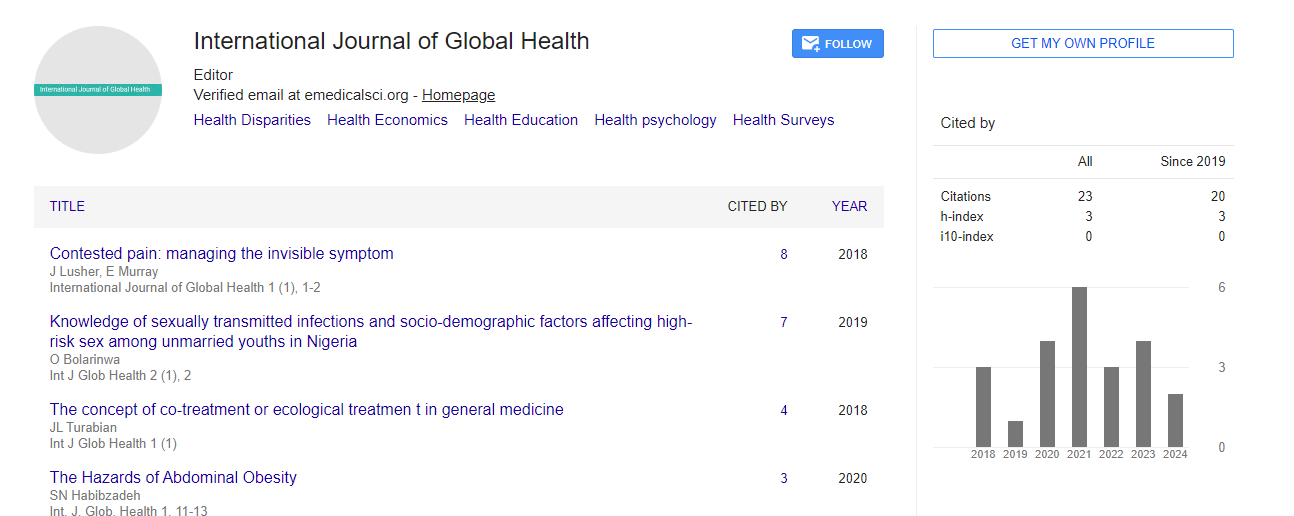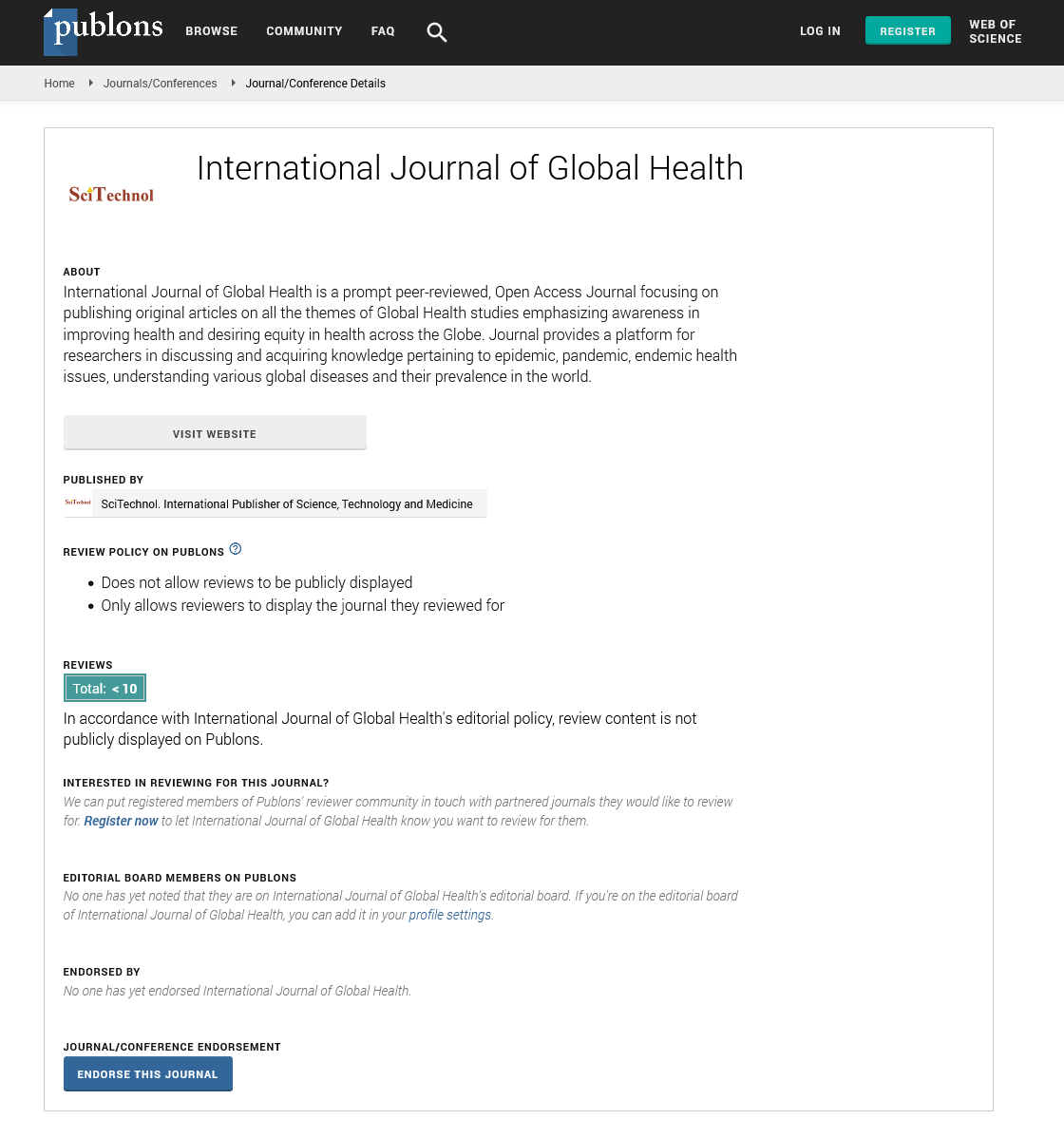Commentary, Int J Glob Health Vol: 7 Issue: 3
The Impact of Paget's disease on Bone Health: A Review
Dandan Ma*
1Department of Orthopaedics, Fujian University, Fujian, China
*Corresponding Author: Dandan Ma,
Department of Orthopaedics, Fujian University,
Fujian, China
E-mail: 1596009@163.com
Received date: 26 August, 2024, Manuscript No. IJGH-24-148993;
Editor assigned date: 28 August, 2024, PreQC No. IJGH-24-148993 (PQ);
Reviewed date: 11 September, 2024, QC No. IJGH-24-148993;
Revised date: 19 September, 2024, Manuscript No. IJGH-24-148993 (R);
Published date: 25 September, 2024, DOI: 10.4172/Ijgh.1000212.
Citation: a D (2024) The Impact of Paget's disease on Bone Health: A Review. Int J Glob Health 7:3.
Abstract
Description
Paget's Disease of Bone (PDB) is a chronic disorder characterized by abnormal and excessive bone remodeling. This condition leads to enlarged and weakened bones, increasing the risk of fractures and other complications. While the exact etiology of Paget's disease remains unclear, it is believed to involve a combination of genetic, environmental and possibly viral factors. This study provides a comprehensive overview of paget's disease, including its pathophysiology, clinical features, diagnosis, treatment and management strategies. Paget's disease primarily affects the pelvis, skull, spine and long bones. The disease is characterized by three main phases.
In lytic phase osteoclastic activity dominates, leading to increased bone resorption. This phase is marked by the presence of osteoclasts that are enlarged and more numerous than in normal bone. Mixed phase there is an increase in both osteoclastic and osteoblastic activity. This phase results in a chaotic pattern of bone remodeling, leading to the formation of woven bone, which is structurally inferior to normal lamellar bone and sclerotic phase osteoblastic activity predominates and resulting in excessive new bone formation. However, the newly formed bone is often disorganized and weaker than healthy bone. The overall effect of these changes is the formation of larger but structurally compromised bones, which are prone to deformities and fractures.
Epidemiology
Paget's disease is more common in older adults, typically affecting those over the age of 50. The prevalence varies geographically, being particularly high in certain regions such as the United Kingdom, Australia and some parts of Europe. It is less common in Asia and Africa. Men are affected more frequently than women, with a male-tofemale ratio of approximately 2:1. Many individuals with Paget's disease are asymptomatic and the condition is often discovered incidentally through imaging studies. However, when symptoms do occur, bone pain is the most common symptom and can be localized to the affected bones. Pain may be due to increased metabolic activity, deformities, or secondary arthritis. The disease can cause noticeable deformities in the affected bones. Common examples include bowing of the legs, an enlarged skull and changes in the curvature of the spine. Weakened bones are more susceptible to fractures, particularly in weight-bearing areas. If the disease affects the skull or spine, it can lead to nerve compression, resulting in symptoms such as hearing loss or spinal stenosis. Rarely, Paget's disease can lead to increased blood flow through the vascularized bone, putting extra strain on the heart.
Diagnosis of paget's disease
The diagnosis of Paget's disease is based on clinical findings, laboratory tests and imaging studies. A thorough medical history and physical examination are essential. Physicians typically assess for pain, deformities and any neurological symptoms. Blood tests often reveal elevated alkaline phosphatase levels, indicating increased osteoblastic activity. Other parameters, such as calcium and phosphorus levels, are usually normal. X-rays can reveal characteristic findings such as bone enlargement, cortical thickening and a "cotton wool" appearance in the skull. Bone scintigraphy scan can detect increased metabolic activity in the affected bones, helping to identify areas of active disease. Magnetic Resonance Imaging (MRI) and Computed Tomography (CT) imaging techniques may be utilized for detailed assessment, especially in cases of complications like fractures or neurological involvement. The primary goal of treatment is to alleviate symptoms and prevent complications. Bisphosphonates are the mainstay of treatment for paget's disease. Bisphosphonates, such as alendronate and zoledronic acid, help to inhibit osteoclast activity, thereby reducing bone resorption and pain. They are effective in controlling symptoms and preventing complications. Calcitonin hormone can also be used to manage symptoms, although it is less effective than bisphosphonates. For pain management analgesics, such as Non-Steroidal Anti- Inflammatory Drugs (NSAIDs), can be employed to relieve pain associated with paget's disease. In cases where deformities or fractures occur, surgical intervention may be necessary. Common surgical procedures includes osteotomy helps correcting bone deformities to improve function and appearance. In cases of severe arthritis secondary to Paget's disease, joint replacement surgery may be warranted. Surgical stabilization of fractures may be needed in severely affected bones.
Conclusion
Paget's disease of bone is a chronic condition characterized by abnormal bone remodeling, leading to a range of symptoms and potential complications. Early diagnosis and appropriate management can significantly improve patient outcomes and quality of life. Bisphosphonates are the basis of treatment, helping to alleviate pain and prevent complications. Regular follow-up and monitoring are essential for managing this condition effectively. Continued research is needed to better understand the underlying mechanisms of Paget's disease and to develop more targeted therapies.
 Spanish
Spanish  Chinese
Chinese  Russian
Russian  German
German  French
French  Japanese
Japanese  Portuguese
Portuguese  Hindi
Hindi 
